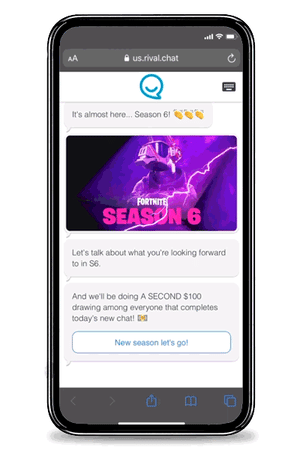.webp)
91% of Gen Zs between the age of 14 to 18 will own a smartphone by 2020
Generation Z is the next puzzle researchers need to figure out. The cohort that follows millennials, Gen Z consumers are the first true digital natives. Many of them don’t remember a time without the internet, and they grew up during the rise of mobile technology.
As more Gen Z consumers enter the workforce, their purchasing power will grow significantly. That’s why it’s important for the market research industry to figure out now how to effectively engage these young consumers for feedback and insight.
But to get Gen Z consumers to participate in research, our industry can’t afford to stick to status quo. I have two sons who are both Gen Zers, and I can tell you from experience that their expectations are very different from previous generations. As an industry, we have to re-examine everything we do if we want to meet the demands of younger consumers.
A study from Reach3 Insights involving hundreds of Gen Z gamers provides important takeaways on how to best engage with the mobile-first generation. The study examined attitudes, behaviors and expectations towards Fortnite, the popular multiplayer game from Epic Games.
 The study included a series of six conversational surveys (or chats, as you’ll discover below) using Rival's market research platform leading up to the Season 6 launch of Fortnite. Overall, we received more than 900 completes and a 62% response rate. We engaged mostly teens and tweens: the average age of the people who talked to us was 17.
The study included a series of six conversational surveys (or chats, as you’ll discover below) using Rival's market research platform leading up to the Season 6 launch of Fortnite. Overall, we received more than 900 completes and a 62% response rate. We engaged mostly teens and tweens: the average age of the people who talked to us was 17.
Reach3’s findings provide interesting insights on the future of gaming, media and other industries. For market researchers, the high engagement Reach3 saw for this study also highlights best practices to consider when engaging with Gen Z consumers for research.
Email is the most common channel researchers use to distribute surveys. A decade ago, this was fine since inboxes weren’t as crowded. But now that we’re living in an era of email overload, this channel is becoming less and less effective.
Today most people don’t use their emails outside of work, relying more on messaging applications to talk with friends and family. Tweens and teens, in particular, are rarely on email. Many of them open an email account only to be able to join apps or services that require it.
The best way to reach Gen Zs for market research is via mobile devices. According to eMarketer, 91% of Gen Zs between the age of 14 to 18 will own a smartphone by 2020.
To that end, for this study, Reach3 chose to recruit gamers through Instagram, one of the most popular platforms among Gen Z today. To reach as many people in the shortest amount of time possible, we partnered with TheSquatingDog, a popular Twitch broadcaster and Fortnite player, who posted about the study in an Instagram story. In less than 24 hours, TheSquatingDog’s post got thousands of clicks and hundreds of responses. I don’t think we would have gotten as much interest if we used traditional means of recruitment. Choosing the right channel was key to reaching the audience that we wanted to talk to.
The more researchers can mirror human conversations, the more likely customers will participate and give their time and honest feedback. In real conversations, you wouldn’t say “on a scale of 1 to 10, how would you rate this?”—but this type of questioning is common practice in research.
Striking the right language and mirroring real conversations becomes even more critical when engaging with Gen Z consumers. If the way you ask your questions isn’t authentic to their voice, you risk losing the attention of these young people. In our study, we knew we couldn’t be terse: a casual and playful tone was more appropriate since we were talking to younger consumers.
The length of your surveys is another consideration. For Reach3’s study, since we were engaging gamers through a Instagram, a mobile-only platform, we kept our questions short.
When it comes to keeping your surveys conversational, the technology that you choose also matters. Reach3 used software from my company, Rival Technologies, to send conversational surveys ("chats") through social media and messaging apps.
If you’ve never used chats to deploy surveys before, you might be wondering why you’d want to do so. Chats are simply more engaging than traditional surveys. A 2018 study we conducted found that people found answering questions through chats more enjoyable, more fun and easier to complete than email surveys. And compared to other means of distributing surveys, the experience in chats feels more similar to how consumers talk to each other online. Companies such as the NFL and the Vancouver Canucks already use chats via messaging platforms to conduct more immersive market research.
When people talk to each other online, they use images, animated GIFs, emojis and videos. There’s no reason why your surveys shouldn’t use these types of media as well.
In this study, Reach3 leveraged fun visuals to deliver a more engaging experience. They also provided players with an opportunity to answer questions with videos and photos.
The results are compelling. Many participants shared photos of where they usually play Fortnite. Through selfie videos, more than a hundred participants told us why they love the game. Those videos allowed respondents to tell us stories and experiences in their own words and revealed emotions that would have been difficult to capture with text responses alone.
Of course, many researchers already know the importance of videos. After all, experts are predicting that video will consist of up to 80% of the world’s internet traffic by 2019. The reality, however, is that it’s almost impossible to get younger consumers to do videos in a traditional online surveys or discussions. Even with extra incentives, people don’t seem eager to record and upload videos. The fact that we got that many videos suggests that consumers are willing to provide this type of content if the technology and approach are conducive to it.
To resonate with Gen Z consumers, it’s important to re-examine your research programs now. Capturing the authentic insights of this generation requires immersive and more conversational approaches. Reach3’s study shows that experimenting with new ways of conducting research is worth the investment as it leads to high participation and richer insights.
If you'd like to learn more about Rival's capabilities in recruiting and engaging Gen Zs for market research, please get in touch with our team.
Sign up for our blog to receive the latest news, trends and best practices from our research experts.


No Comments Yet
Let us know what you think